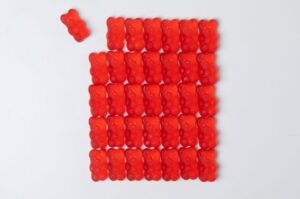
Are you a tea enthusiast looking to explore new flavours and colours? If so, then you must try Blue Matcha, the latest Meta trend in the world of teas. With its striking blue hue and numerous health benefits, Blue Matcha is gaining popularity among health-conscious individuals and culinary enthusiasts alike. In this blog, we will take a closer look at what Blue Matcha is, its origins, health benefits, culinary uses, preparation methods, and more.
What is Blue Matcha?
Blue Matcha, also known as Butterfly Pea Flower Matcha, is a powdered tea made from the flowers of the Clitoria ternatea plant, commonly known as Butterfly Pea Flower. The vibrant blue colour of the tea comes from the natural pigments found in the flowers, which are rich in anthocyanins, a type of antioxidant. The flowers are harvested, dried, and then ground into a fine powder, which can be used to make a variety of hot and cold beverages, desserts, and savory dishes. Pink Matcha and Red matcha are the other examples of trending coloured matcha products,
Origins of Blue Matcha
Blue Matcha has its roots in Southeast Asia, particularly in countries like Thailand, Malaysia, and Vietnam, where the Clitoria ternatea plant is native. The plant has been used for centuries in traditional medicine for its medicinal properties and as a natural food colouring agent. In recent years, Blue Matcha has gained popularity globally due to its unique colour and potential health benefits.
Health Benefits of Blue Matcha
Blue Matcha is not only visually appealing but also packed with numerous health benefits. Let’s take a look at some of the key health benefits associated with Blue Matcha consumption:
- Antioxidant Properties
Blue Matcha is rich in antioxidants, particularly anthocyanins, which are known for their powerful antioxidant properties. These antioxidants help to neutralize harmful free radicals in the body, which can cause oxidative stress and damage to cells. Regular consumption of Blue Matcha may help to reduce the risk of chronic diseases, such as heart disease, cancer, and diabetes, and promote overall health and well-being.
- Detoxification
Blue Matcha has natural detoxifying properties that can help to cleanse the body of toxins and promote healthy liver function. The antioxidants in Blue Matcha help to support the body’s natural detoxification processes, aiding in the elimination of harmful substances from the body and promoting optimal liver health.
- Brain Health
The anthocyanins found in Blue Matcha have been shown to have neuroprotective properties, which may help to improve cognitive function and protect against age-related cognitive decline. Regular consumption of Blue Matcha may also help to enhance memory, focus, and concentration, making it a great choice for those looking to support their brain health.
- Weight Management
Blue Matcha is a low-calorie beverage that can be incorporated into a healthy diet for weight management. It contains no added sugars or fats and is naturally low in calories, making it a healthier alternative to sugary beverages or calorie-laden snacks. Blue Matcha can also help to boost metabolism and increase energy levels, which may aid in weight loss efforts when combined with a balanced diet and regular exercise.
Culinary Uses of Blue Matcha
In addition to its health benefits, Blue Matcha is also a versatile ingredient in culinary applications. Its unique blue colour adds a pop of vibrancy to various dishes and beverages, making it a favourite among culinary enthusiasts.
Here are some creative culinary uses of Blue Matcha:
- Beverages
Blue Matcha can be used to make a wide range of beverages, both hot and cold. Traditional Blue Matcha tea, also known as Blue Matcha latte, is made by whisking Blue Matcha powder with hot water and optionally adding sweeteners or milk of choice. Blue Matcha can also be used to create refreshing iced teas, smoothies, cocktails, and mocktails. Its stunning blue colour adds a visually appealing touch to any beverage.
- Baking
Blue Matcha can be used to add a unique twist to baked goods. It can be used as a natural food colouring agent to create blue-hued cakes, cookies, muffins, and other baked treats. Blue Matcha can also infuse its subtle earthy flavour into baked goods, adding a hint of floral notes to the final product. Baking with Blue Matcha can be a fun and creative way to experiment with unique flavours and colours in the kitchen.
- Cooking
Blue Matcha can be used in savory dishes as well, adding a pop of colour and flavour to various culinary creations. It can be used as a natural food colouring agent in sauces, dressings, soups, and rice dishes, giving them a visually appealing blue hue. Blue Matcha can also add a unique earthy and floral flavour to savory dishes, making it a versatile ingredient in culinary experiments.
How to Prepare Blue Matcha
Blue Matcha can be prepared using traditional or modern methods, depending on personal preference and convenience. Here are two common methods for preparing Blue Matcha:
Traditional Method
- Boil water and let it cool for a minute to reach a temperature of around 80°C (176°F).
- Add 1 teaspoon of Blue Matcha powder to a matcha bowl or cup.
- Pour a small amount of hot water over the Blue Matcha powder and whisk vigorously in a zig-zag motion using a bamboo matcha whisk or a handheld frother until frothy.
- Add more hot water to fill the cup and whisk again to create a consistent foam.
- Optionally, add sweeteners or milk of choice to taste.
- Enjoy your traditional Blue Matcha tea!
Modern Method
- Boil water and let it cool for a minute to reach a temperature of around 80°C (176°F).
- Add 1 teaspoon of Blue Matcha powder to a mug or cup.
- Pour the hot water over the Blue Matcha powder and use a spoon or a handheld frother to whisk vigorously until frothy.
- Add sweeteners or milk of choice to taste.
- Enjoy your modern Blue Matcha tea!
Conclusion
Blue Matcha is a unique and versatile ingredient that offers a plethora of health benefits, from its antioxidant properties to its potential for supporting brain health and weight management. It’s stunning blue colour and subtle earthy flavour make it a favourite among culinary enthusiasts for creative culinary applications. Whether enjoyed traditionally as a hot tea or incorporated into modern beverages, baked goods, and savory dishes, Blue Matcha can add a vibrant twist to your culinary adventures.
Read Next Blog:
Benefits of Drinking Green Matcha Tea







